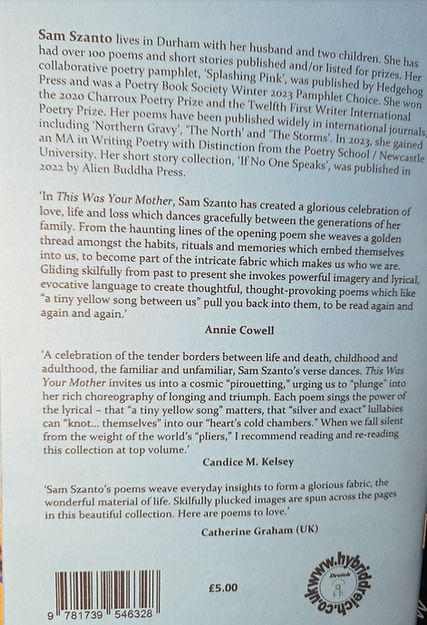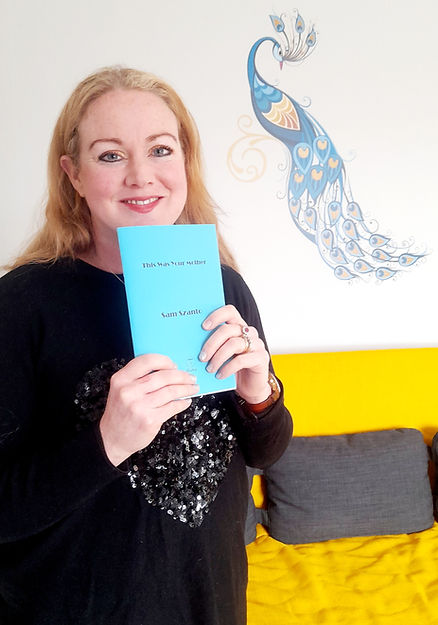Candice Kelsey: 'What are poems but life’s postcards?'
- samszanto2
- Apr 23, 2024
- 5 min read

A chat with Candice Kelsey about her poetry collection, ‘Postcards from the Masthead’ (boats against the current press, 2024)
I love the idea of the form of the book as a series of postcards – where did that idea come from?
I’ve been reading (and teaching) James Tate recently, and his literal postcard of a poem titled “Postcard (October 25, 1985)” grabbed me by the throat and shook me in the nicest way possible – with inspiration and epiphany. I then thought of Billy Collins’ brilliant naming of the postcard as an “American Sonnet,” the final two stanzas reading: “a few square inches of where we have strayed / and a compression of what we feel.” Also, my obsession with Basho rivals the fiercest of Swifties, and what is a haiku but a few square inches of compressed goodness? One of the most endearing aspects of being part of the poetry community is the sharing of poems – across the miles, social media expanse, and life’s seemingly fortified walls. What are poems but life’s postcards? May all our postmarks be beauty.

How would you describe the collection in one sentence?
These poems are an exploration of the ways in which we try to connect in the 21st Century (with each other and with the Earth), often failing but always yearning, like Melville’s Ishmael and all other 19th Century whalers who traded letters during gams (the passing of ships in the middle of the ocean).
You’re so inventive with form in the collection – I now know what a duplex is! I wonder if there was a reason for that experimentation in this collection in particular? And whether you have a favourite form?
I’ve always been a fan of constraint writing, an affinity that came about in graduate school after being introduced to the French OULIPO movement, especially Georges Perec and Marcel Benabou. I think that’s why I’m attracted to strict form poems. Recently I took the amazing Taylor Byas’ Pantoum, Sestina, and Sonnet Workshop (with the Minison Project) which only stoked the fires. And thank you, Jericho Brown, for birthing the duplex, right?! Finally, I teach a large percentage of Persian students, and in my quest to engage them in form poetry, I introduced a unit on the ghazal. My collection has a nautical theme – water is the ultimate conductor of electrical current, shapeless and unwieldy. Not unlike grief. Much of this collection is anchored in grief – over the loss of my father and simultaneously the loss of our ecology, as signified by the calving of the Thwaites “Doomsday” Glacier. So, in this “boggy, soggy, squitchy” collection, I thought strict poetic forms could offer much-needed structure and stability. I guess what I’m saying is poetry is the ballast in my crazy, little ship.
How long did the book take to write?
Some of these poems have been reworked over the past three or four years; some are brand new. I knew I wanted to create a chapbook as an ode to my recently deceased father, an unabashed lover of the ocean who modeled for me a tenderness toward the Earth, so I had been assembling the manuscript over the past year. In a sense, his death has brought me even closer to identifying with the great cosmic orphan, Ishmael; hence, the book’s dedication for every Ishmael.
How did you structure the collection?
I tried to emulate the natural rhythm or gulf stream of human communication – how we send or sometimes don’t, how often our missives are lost, misunderstood, or returned, and how even so, we keep trying to connect.
How did the design for the cover come about?
Honestly, the cover art is a dream come true! I have been a long-time fan girl of the wildly talented artist and illustrator Matt Kish (https://www.matt-kish.com/) whose Moby-Dick in Pictures: One Drawing for Every Page is an essential text in my personal and professional library. I knew I wanted one of his pieces to be the cover, but I had little to no hope that I could manifest such good fortune. Readers, he came through!
How did you choose a publisher for the collection, and how much editorial input did they have with the book?
If you don’t know the fabulous McKenna Themm and boats against the current https://boatsagainstthecurrent.org, you are missing out! They have published a few of my poems over the years, and I was always impressed with their professionalism, artistic vision, and integrity. Sending this collection to them was a no-brainer, like choosing Queequeg for your harpooner! It has been an absolute joy working with them.
What has been the reaction to the book? Have there been any individual reactions that have surprised you?
It’s a bit too early to know yet, but I was thrilled that three of my literary crushes, Tara Stillions Whitehead, Joan Kwon Glass, and Natalie Marino endorsed the collection. I’d love to hear from anyone else who’s read it – let’s gam.
Do you have a favourite poem from the book?
The “Pandemic Pantoum on the Peninsula, Marina del Rey” is a favorite. My family is woven into the stanzas, but also the geography of my home. And the repetition of the form, of course, lends itself to echo the monotony of months in lockdown. The overarching message of finding common ground – connecting, if you will – with others, even those that are initially hostile, is the beautiful stuff of life even mid-pandemic. The poem also points to the hope that perhaps even in our anthropocene hostility toward our home, we can find some reconciliation.
There are two poems after Archibald McLeish – what does his poetry mean to you?
Well, his “Ars Poetica” has been a compass to me as a fledgling poet. And in my collection, I hold fast to his idea that “poems should not mean / but be,” in that language (postcards, for example) is an art in and of itself, whether it reaches its intended recipient or not. I aim to highlight the silty, slippery, and dangerous nature of language as well. Currently I’m reading – devouring, more accurately – genius Percival Everett’s novel James, another water narrative, albeit a river, which explores, among other important concepts like the nature of freedom, the subversiveness of language.
Ars Poetica
BY ARCHIBALD MACLEISH
A poem should be palpable and mute
As a globed fruit,
Dumb
As old medallions to the thumb,
Silent as the sleeve-worn stone
Of casement ledges where the moss has grown—
A poem should be wordless
As the flight of birds.
*
A poem should be motionless in time
As the moon climbs,
Leaving, as the moon releases
Twig by twig the night-entangled trees,
Leaving, as the moon behind the winter leaves,
Memory by memory the mind—
A poem should be motionless in time
As the moon climbs.
*
A poem should be equal to:
Not true.
For all the history of grief
An empty doorway and a maple leaf.
For love
The leaning grasses and two lights above the sea—
A poem should not mean
But be.
Archibald MacLeish, “Ars Poetica” from Collected Poems 1917-1982.
There are quite a few long poems in the book. Rachel Zucker says about the long poem that it allows ‘a poet multiple chances to change her mind and switch strategies and develop the kind of relationship with her reader that can withstand some highly unpoetic moments. It’s a bit like marriage, the long poem.’ I wondered what your thoughts are on that?
Oh, I’m sure there are many “unpoetic moments” in much of my work! But yes, to Zucker’s point, the longer poem is nothing if not, like all marriages or relationships for that matter, a risk. But of late, I am recommitted to ludicrous optimism. I suppose that’s what those longer pieces are banking on – a ludicrous optimism that the reader will stay in the poem like an eager whaler out for a three-year voyage. Or our children wanting to preserve the Earth.
Buy Postcards from the Masthead here:
Learn more about Candice on her website: https://www.candicemkelseypoet.com/










Comments